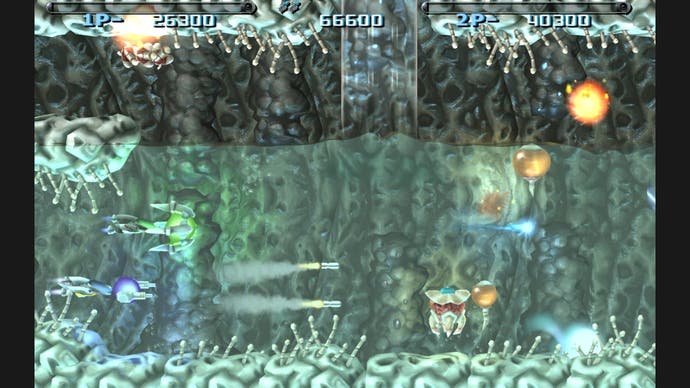R-Type Dimensions
Two by Force.
As well as its standard pulse gun the ship also packs a plasma cannon, triggered by holding down the A button to accumulate beam energy. In R-Type you release the button when the gauge is filled to fire a powerful plasma beam while, in its sequel, the cannon has two charge stages. As your standard weapon ceases to fire while you charge your cannon the design implication to the player is significant: should you risk pausing your onslaught for a heavier punch or carry on chipping away at your enemies' with pulse jabs?
There are two ways to play both games: standard Arcade mode or Infinite mode. In the former you have three lives with the game ending when they are lost. When you die you lose your weapons and Force and are returned to the nearest checkpoint. If you choose to continue on the Game Over screen then your score is wiped, the challenge being to clear either game with a single 'credit'. By contrast, Infinite mode grants you unlimited lives but records the number used to complete the game on the leaderboard for all to see. Infinite mode is SouthEnd's concession to beginners, allowing everyone to see the games in their entirety without diluting the core challenge for experts and those willing to train for excellence.
There are, however, a few niggling oversights that ensure this rerelease falls short of other top line XBLA examples such as Rez HD and Ikaruga. For one, the lack of difficulty settings, which were present in the original arcade version, is inexplicable. That the update's difficulty seems to be set above the default arcade dip switch setting makes the decision all the stranger. As a result, this is a game that, more than ever, will only reward deep and concentrated player investment.

But the most immediate problem, particularly for those players with deep muscle memory of the original games, is the lack of a button reconfiguration option. The placement of Force on the X button seems strange to my hands and without any option to shift it over to the B button, the default (and only) configuration demands players grow accustomed to its idiosyncrasies. The default auto-fire option is less than the fastest fire rate (achieved by tapping the fire button as fast as you can) so in this regard the game rewards players who use an arcade stick rather than the default Xbox 360 pad.
While there are a number of graphical, MAME-style filters for the 3D game appearance, there are no such options (not even scan lines) for the pure 2D aesthetic, another strange decision. Finally, the lack of an option to download other players' replays, which has become almost a genre standard for XBLA shooters, is a shame, especially as some expert tips would have been a help for players looking to improve their game. The new co-op modes, for both local and online play, are welcome. Both Arcade ad Infinite modes can be played like this with the option to add player collision for added difficulty. Classic co-op allows you to revive a fallen companion with a special power-up or at completion of a stage. Lives are shared and a life is lost only when both ships are destroyed at the same point - a neat idea.
The result is a tough but lovely recreation of two of the greatest orthodox shoot-'em-ups ever made. There's no denying that both titles are products of the genre's formative years and, in terms of both graphical splendour and range of game mechanics they falter next to the likes of Gradius V or even R-Type Final. But what the games lack in breadth they make up for in depth, offering a mesmerising ride through an experience way ahead of its time. To more fully answer Irem's 1987 question then, 'Probably not. But we'll give it a damn good try.'
